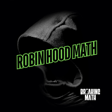Become a Creator today!Start creating today - Share your story with the world!
Start for free
00:00:00
00:00:01

54: Oodles (Large Numbers)
There are a lot of things in the universe, but no matter how you break them down, you will still have far fewer particles than even some of the smaller of what we're calling the 'very large numbers'. Many people have a fascination with these numbers, and perhaps it is because their sheer scale can boggle the mind. So what numbers can be called 'large'? When are they useful? And what is the Ackermann function? All of this and more on this episode of Breaking Math
[Featuring: Sofía Baca; Diane Baca]
Ways to support the show:
Patreon
Become a monthly supporter at patreon.com/breakingmath
Merchandise
Purchase a Math Poster on Tensor Calculus at our facebook store at facebook.com/breakingmathpodcast
Transcript
Introduction and Audio Quality
00:00:00
Speaker
Today's episode was recorded with masks on. Please excuse the quality as we continue to battle COVID.
Intrigue of Large Numbers
00:00:07
Speaker
There are a lot of things in the universe, but no matter how you break them down, you will still have far fewer particles than even some of the smaller of what we're calling the very large numbers. Many people have a fascination with these numbers, and perhaps it is because their sheer scale can boggle the mind. So what numbers can be called large? What are they useful? And what is the Ackermann function? All this and more on this episode of Breaking Math.
Introducing Guest: Diane Baca
00:00:36
Speaker
I'm Sophia and you're listening to Breaking Math. With us we have on Diane Baca, my mom. Hi everybody. And she's been on a couple other episodes, the game theory one, the great Stata
Promotions and Social Media
00:00:49
Speaker
Jim heist. But before we go into the topic of today's episode, which is large numbers, I'm going to do a few plugs.
00:00:55
Speaker
The holidays are coming up, and it might arrive a little bit late if you are hearing this podcast. But our Facebook poster store is back online, and the poster is $15.15 plus shipping and handling, which is $19.65 within the United States. If you want to donate to our podcast regularly, we have a Patreon at patreon.com slash breakingmath. That actually helps us quite a bit. The littlest amount, $1, $5 you could do. If you donate $22.46, you can get a poster with that.
00:01:25
Speaker
But if you're a patron, you can have outlines from the show and we have the episodes there without ads. If you want to find out about the show, just go to our Facebook page and find out updates about the show or on Twitter at Breaking Math Pod. Our website is at breakingmathpodcast.app and we have a sister podcast touring rabbit holes that you can go
Exploration of Large Numbers: Avogadro to Myriad
00:01:45
Speaker
listen to. But yeah, so large numbers. What do you know about large numbers?
00:01:49
Speaker
Me? I know that they are the really large numbers we assign names to. We also, we do large, I guess very small numbers, which could be considered very large small numbers. We do like say like Avogadro's numbers, so I know that those exist. And that is 6.02 times 10 to the 23rd, right?
00:02:11
Speaker
Yes, yes, so I know that we do name numbers and we figure out a way to like talk about them, I guess is what I'm thinking. Yeah, and that number is, I mean, it's pretty big, obviously, but we're going to be dealing with some insanely big numbers today. But as a quick outline of the show, we're going to go through some early examples of large numbers. We're going to talk about Google, Neuth's up arrow notation for denoting large numbers, Grab's number, and the Ackman function.
00:02:40
Speaker
All right, so in early Greece, they had the concept of a myriad, which meant both 10,000 or basically indefinitely large. And we still use that same use today. It's funny, we use it just to describe a bunch or a big selection of things. Oh, they had a myriad of that. Yeah.
00:02:56
Speaker
Yeah, and they did use this usefully, but obviously it'd probably be for tributes and stuff like that. But it was an M with a bar over it or other numerals over it. So if you had M with the Greek numerals for 234 over it, it would mean 2,340,000.
Ancient Large Numbers: Mayans and Indians
00:03:11
Speaker
So they actually had a concept of two million back then? Oh, yeah, they did. I mean, they didn't have a need for it. Well, I mean, I don't I shouldn't say they don't have a need for it. I'm just wondering what they're in trade. They probably needed to use it to know that they were they were probably dealing with large quantities of like at least shells and stuff like that. Two millions a lot, though. You think about it. It's like it's kind of interesting that they had that concept.
00:03:33
Speaker
Oh yeah, but if you think about it over the course of a year, it's like 3,000 things a day is a million a year. Okay, never mind, that is pretty much it. That makes sense then, yeah. But yeah, the Mayans also had a concept of very large numbers. The long count calendar, for example, has 1.678 times 10 to the 31st days in it.
00:03:56
Speaker
What is that long count calendar? It's like cycles within cycles. Like the date of creation is supposed to be about halfway through, which is 13 dot 13 dot 13 dot 13 dot 13. And then there's, there's our one, two, three, four, five, six, seven, eight, nine, 10. There's 2013 in a row. So I don't understand. Why are there 13 dot 13 dot 13? I've never seen a number written like that. Oh, it's in base 20.
00:04:22
Speaker
Oh, so you're saying it's a it's a calendar and it's actually base 20 except for the second digit from the right, which is base 18. Why wouldn't it just be counting to if it's base 20? Why wouldn't it be going up to nine or oh, wait, that's just the date of creation. So it could be like it like another valid date of creation would be like 19 dot 18 dot two dot three.
00:04:44
Speaker
That is so weird to me. I can't even get a concept of that. Even the 10 to the 31 is impossible for me to imagine. Yeah, that's far longer than the universe has ever existed. It's longer by basically if every day, every day would have to be about as long as the universe. And then even then you wouldn't be adding up to all this.
00:05:02
Speaker
That particular number? Wow, that's huge. I was going to ask you how many years that was. But yeah, because I mean 10 to the let me see how many years I'm going to calculate it is slightly wrong. It is 1.51 times 10 to the 31st days, but still. That is 4.137 times 10 to the 28th days. I mean, years. Oh, heck. Which is that's like into the aliens that we don't even talk about.
00:05:33
Speaker
Yeah, which is that would be a billion billion 10,000 million years. That's hard to understand. This is why I guess we need really large numbers.
00:05:43
Speaker
Yeah, and there's a thing about them too is that they really are kind of impossible to understand. It's just that we just kind of know that they get bigger and bigger. And we run into them in like, usually in situations like we're counting things I've noticed, like one number that we're going to be talking about later, Graham's number,
00:06:04
Speaker
is found in Ramsey theory, which is counting the number of possible solutions. So it's like saying, how many possible, how many different combinations would I need to come up with this outcome, basically? Right. So they're counting combinations. Or like in the case of Avogadro's, you're counting like tiny, tiny, tiny things, you know, like atoms, or I guess they probably use these things in, in what, in universe counting or in stars or whatever.
00:06:31
Speaker
Well, even stars, there's only a there's only the number of particles in the universe that we'll be talking about in a second. But even that is not as high as you might think. So I guess I wonder why we need to create these numbers when they really don't exist in the world or it's for measuring mathematical concepts.
00:06:48
Speaker
oh okay okay never mind but the ancient indians had maybe the biggest uh concepts of large numbers amongst um ancient people for example they had the bodhisattva which is 10 to the one dodecillion uh about
00:07:05
Speaker
Doe Dicilian? Yeah, one Doe Dicilian, 37 Undicilian, 218 Dicilian, 383 million, 881 octillion, 997 septillion, 644... Quintillion? Quintillion, 441 quadrillion, 306 trillion, 597 billion, 687,000 million, 849,648, and then I missed one somewhere because there's 120 after that. Oh my god, that's crazy.
00:07:34
Speaker
But yeah, these are used for religious purposes. In what way? Counting numbers of days. I mean, the Lalita Vista Rautra is 10 to the 200 infinities, which is Google squared. So the idea is that it's infinity. Yeah, I think it's just meant to boggle the mind and meditate on it.
00:07:58
Speaker
Okay, that would make sense because it does mine. And then paro is 10 to the 400 quadrillion infinities. And 10 to the 400 quadrillion means 1 with 400 quadrillion zeros after it, which would take basically thousands and thousands of hard drives just to hold the zeros. I was going to say, like, it's not even something you could write. It's purely a concept.
The Enormity of Google and Googleplex
00:08:22
Speaker
Google is 10 to the 100th power, which is just one with 100 zeros after it, and is actually the first large number that I was aware of. And Google, it's spelled G-O-O-G-O-L, and the company is only named after it. But just to talk about how big of a number just this is, there'd be less than a Google of atoms of hydrogen if all of the dark matter and the matter in the universe were converted to hydrogen.
00:08:46
Speaker
You would have to basically take, for every hydrogen atom that was made out of the mass of the entire observable universe, you'd have to replace it with as many fish tanks as it would take, 10 gallon fish tanks that it would take to fill the ocean. And that's a Google.
00:09:01
Speaker
So you're saying basically if we broke everything down in this universe and we split it back into molecules of hydrogen which is just one atom. Yeah and we're talking about matter and dark matter and remember that matter is only a small percentage of dark matter. Actually yeah that's a whole other thing for me I'm not aware. I don't really know a whole lot about dark matter so I'll just accept it okay. That's basically what the physics community did it's like oh man dark matter exists I guess we have to accept it.
00:09:28
Speaker
Okay, I'll take that. Oh my gosh, so that's really crazy. Basically, you're saying that I didn't get the fish tank thing. So so you're saying so let's say that we have all these hydrogen atoms made out of the old universe. Okay, now we take each one of those hydrogen atoms and we replace it with as many hydrogen atoms as it would take 10 gallon 10 gallon fish tanks to fill the ocean.
00:09:49
Speaker
Oh, that's a weird concept. Okay. I couldn't find a big, it's hard to talk about these numbers. Well, especially 10 gallon to imagine how many 10 gallon fish tanks in the ocean. That's not even conceivable either. Cause that's crazy, right? Cause it's about 10 to the 20th. And it's really hard to talk about that number. I know it's crazy. These numbers are really big.
00:10:07
Speaker
And that's also the thing, it's like astronomers have this problem where they're talking about these large objects and they can't really wrap their heads around how big they are. I mean, even the earth is too big for humans to really comprehend. Yeah, it's, it's, yeah. And maybe that makes sense the reason why you said, you know, that they sometimes incorporated into religion. It makes sense to me now, you know, the undefinable, the unachievable or under, you know, not understandable. And then we've got to talk about Googleplex, which is 10 to the 10 to the 100th.
00:10:36
Speaker
Why did we need that? Because it's one with a Google zeros after it. We didn't need Google. I guess we just have to do stuff like this, huh? Okay. Yeah. And if we all just stopped using Google, maybe Google wouldn't have as much control over everything. You know, get the number. A little editorial there. No, it's not an editorial. I'm just talking math. Oh, okay. Okay. Yeah. I'm just talking about, you know, if everybody stops searching for reasons to use Google everywhere.
00:11:07
Speaker
So now we're going to talk about much bigger numbers than that. Because they need to exist as well. Okay.
Complexity of Knuth's Notation
00:11:13
Speaker
So we're going to talk about Knuth's up arrow notation. And from what I could tell, it was just invented for fun. For me, Google was just created for fun and a Googleplex was created for fun. I mean, if it doesn't really apply in the world that we live, do we really need it? Or is it just for fun?
00:11:30
Speaker
Oh yeah, I mean, most math starts out just for fun. I think that's what a nooths-up-arrow notation is. And this reminds me of when I was a kid, because he said, OK, addition, repeated is multiplication. Repeated multiplication is exponentiation. Well, what's repeated exponentiation? And it turns out that is two up-barrows in nooths notation.
00:11:53
Speaker
So for example, okay, I got you. Yeah. So like two up arrow, up arrow three would be two to the two to the two, which is 16. Wait, well, two to the, two to the third is eight. And then you're saying two to the third to the third. Two up arrows, because that's a new notation. That's not like two exponentiation marks. It's two up arrows. So, and that means how does that equal 16? What are you exactly doing there? Because two to the two is four. And then two to the fourth is 16.
00:12:24
Speaker
okay oh okay that's a new notation i've never seen this before and then two up arrow up arrow four would be two to the two to the two to the two which would be um two to the two to the fourth would be two to the 16th which is 65,536
00:12:41
Speaker
Oh my god, that's so weird. It's kind of hard for me to get it. Like, so you did two to the up up three is two to the two, which is four. Remember, exponentiation reduces from the right. Oh, so it's two to the fourth. And that's why it's the 16th. If I know that it goes to the right, that makes more sense. Yeah. So two up up fourth. So what is that actually saying two to the fourth to the fourth to the fourth? No, two, it would be two to the two to the two to the two.
00:13:11
Speaker
Oh, and that's 2 to the 4th to the 8th 2 to the 8th No, wait, no because uh 2 to the 2 to the 2 to the 2, right? Yes, and so you go from the right side in yeah So 2 to the 2 on the right side is 4 right when 2 to the 4th is 16 16 Okay, so you go from the right 2 to the 2 is 4th 4 times 4 to 2 to the 4th is 16 and then 2 to the 16th I get it. Yes. Okay, so
00:13:37
Speaker
Yeah, it's 65,533. So yes, if you write this out two to the two to the two to the two and then start from the right hand side, it's so much more comprehensible. Yeah. And then, but then like, if you have, and then you run into really fat, really big numbers really quickly, for example, two with four up arrows and then the number four is two to the two to the two to the two. And then there's 65,536 two's. Yeah. Wow. And that's way bigger than a Google.
00:14:06
Speaker
and basically this is just his up arrow notation just it was a his noothe is a his yeah okay it is who double donald oh donald sorry donald as in duck as in duck yes donald noothe oh okay um that's crazy that's kind of fun though i can see how it could be fun
00:14:26
Speaker
And then you might wonder, what is 0 with n up arrows to the b? 1. Well, it turns out that it's either 0 or 1. If it is 0 when n is 0, it's 1 when n is 1 and b is 0. It's 0 when n is 1 and b is greater than 0. So like 0 up arrow 3 would be 0. Wait, just real quick. I forgot this. What is 0 to the 1 power? To the power of 1? 0.
00:14:52
Speaker
How can it be one then? How can it ever be one? Is it zero to the zero power is one? Yep, zero to the zero is one. Okay, I could there's I knew there was some kind of weird definition that I forgot. Yeah, okay. And it actually turns out that it depends if B is even or odd. So if like n is greater than one, then as one would be as even and zero would be as odd.
00:15:12
Speaker
Wow, this is so much easier to understand if you could see it. Yeah. So you're exponentiating. It's, I get it. You're exponentiating the N and the B. Yeah. And then you're using N up arrows. So we have like zero. Oh, I got you. Yeah. So like zero, up arrow, up arrow, up arrow four would be one because four is even. I got you. Okay. That is crazy. And then that's just for fun. Oh yeah. That's just for fun. It just, that's just what, what the math shakes out to be. It's like a mind or a mind game.
Graham's Number Explained
00:15:46
Speaker
So now we're gonna talk about the horror that is Graham's number. Confession, I've never heard of Graham's number. Most people haven't.
00:15:53
Speaker
Oh, really? I hadn't heard a newt's up arrow, but. Yeah. Gram's number. So the, so the problem is this. You have a hypercube, right? Okay. So hypercube is, uh, you're going to basically, you could imagine it as you, you have a square, right? Okay. If you connect two squares by their respective vertices, then you get a cube, right?
00:16:16
Speaker
Well, two squares by, oh, if you connect them. Yeah. Yeah. Yeah. And then it makes, and then think about if you connect the corners too. So there's a bunch of X's everywhere. Okay. Now, if you can, if you make two of those and you connect the respective vertices together and across the X's just like you did before, then you'll have a four dimensional hypercube, even though it's like in three dimensions made of string. And you can keep doing that. Just, it'll be this big tangle of wire, right? I'm going to say yes.
00:16:40
Speaker
Yeah, not wire, like string. Whatever, yeah. So imagine the string are either red or blue. Okay. So the problem is this. What dimension does this hypercube have to be so that no matter how we color the strings, we choose whatever red or blue we want, there'll be at least one square with an X in it that is all the same color. I'm going to accept that. What is the point of that? Well, that's the problem.
00:17:06
Speaker
oh see the problem is what is and like what is what is that number that'll give you that square with the
00:17:13
Speaker
yeah so like what how many dimensions that there have to be and it turns out that the lower bound as of 2008 is 13 so it takes at least 13 dimensions but it might be a lot higher than that quite a bit higher than that and an early solution to an upper bound was gram's number and to define gram's number we have to define uh the gram's numbers so g1 is three four up arrows three
00:17:38
Speaker
Oh, hey. Okay. So this did turn out to be useful in some ways. You're using that other. Yeah. Noose arrows in order to describe Graham's number. Yeah. And as you can see, as you can imagine, that would already be an immense number, right? Three. Sure. Absolutely. Yes. Now G2 is a three, right? Wait, what is G1 G2? Sorry. G2 is defined in terms of G1. G3 is defined in terms of G2 and so on until we get to G64.
00:18:05
Speaker
What is G1 though? G1 is just three with four up arrows and then three. But I mean, what does the G stand for? Like, what does that mean? Oh, it means like Graham's number. Oh, it's his first. Oh, okay. I'm sorry. Okay. Got you. So Graham's number one is three, four, four up arrows to the third. Yeah. And now G2 is three with G1 up arrows. Got it. To the three.
00:18:27
Speaker
Oh wow. So there's literally this almost infinite number of up arrows. That's insane. Okay. G3 is three with G2 up arrows and then three. Okay. We are so big right now. That's no way. And then you keep going and going and going until you get to G64, which is G, which is three with G63 up arrows and then three.
00:18:45
Speaker
And why did, so what does that prove, that G64, like what is that? Well, G64 is, it was an early solution to an upper bound for Graham's number. So it takes at most that many dimensions and no more. Okay. I'm just curious as of right now, Graham's number was talked about in 1971. Yeah. And that was the number of dimensions that the maximum was.
00:19:05
Speaker
And somebody figured out in 2008 that the lower bound is 13? No, no, the lower bound is still 13, but the upper bound at the time was known to be about six. Okay. But it was between six and G64. Oh, I see. Okay. Okay. So it's either what is either one or some number that is like massive and Cthulhu-ish.
00:19:28
Speaker
But now the upper bound is much much smaller But it's still mind-bogglingly huge which is the number of dimensions that this hypercube must be is 2 to the up arrow up arrow 5138 times 2 to the upper up arrow 5140 1040 take that in upper width twice to the 2 times 2 to the double up arrow 5137
00:19:52
Speaker
Do you think anybody really ever has a concept of this because- No, it's all a game. It's a math game. Okay, because I was like, that's way bigger than a Google or Googleplex or whatever. Oh, yeah, it's insanely big. Okay. Yeah, it just happens to be way, way smaller than Graham's number, which is just ghastly. It's horrifying. Because remember, Graham's number is describing a number of dimensions. And in dimensional hypercube, there's two to the n vertices. So there'd be two to the G64.
00:20:19
Speaker
Whoa. Okay. Yeah. That's yeah. That's massive. That's so huge. Yeah. And that's kind of how I kept like thinking this whole episode. It's like, Oh wow, this number, it's so big. It's just a big number. I got kind of like, after a while I was like, Oh, this number. Yep. It's, it's a big number. I don't understand these numbers. Nobody does. I mean, even a Google is bigger than anyone can comprehend. But it's, it's a method of, of, of, I guess, playing with the mind. Oh yeah. It's playing with the mind and playing with the nature of math.
00:20:49
Speaker
Yeah. Okay. That makes sense to me. That makes sense. Yeah. I do remember when you learned to Google, by the way. Oh yeah. I keep writing it everywhere. Oh my God. You kept talking to me about it and writing it everywhere on paper and everything. And it was very exciting to you. I do remember that. I remember thinking I didn't know what a Google was.
Understanding Ackermann's Function
00:21:09
Speaker
All right, so Ackerman's function generates extremely large numbers, and that's its whole deal. And it doesn't really have uses other than to show some stuff about tail recursivity. It's more of a tool, but
00:21:24
Speaker
But tail recursivity and simple recursivity, I can't remember the exact definition. We might have a episode soon on recursiveness and also sets. But basically, the acumen function is defined in terms of itself, right? I don't know. OK, so the acumen function is at a0n. So a0n, it's a two-dimensional function. It takes in two variables. So a of 0 and n is just n plus 1. That's the definition 1, right?
00:21:54
Speaker
I guess that is. I can see it. I can see it written down. So it's basically a function called A, which is an acronym. I'm assuming that zero is defined and is not. So it looks like it's taking in just one number. Yeah. So now the first argument is greater than zero, so it's M plus one. OK. And the second argument is zero. Then it's the acronym function of M and one. And so far, it doesn't seem to be that horrifying.
00:22:22
Speaker
To me, it just seems like letters and numbers right now. A bunch of letters. And the point is to generate large numbers. Yeah. Well, I mean, it's also just kind of a fun one because it just explodes so quickly. Sometimes mathematicians have competitions of this sort. I'm going to make it a function that explodes quicker than your function and it's going to be completely novel in its construction.
00:22:44
Speaker
Oh, okay. Okay. That makes sense to me. I was like, I was going to ask you who uses this. I mean, is it applicable in any kind of, uh, I've never seen any application for this.
00:22:54
Speaker
Okay. So this is simply math. It really is math defined, defined within the math community or mathematicians or whatever you want to say. Yeah. But also, I mean, as we talked about on the show, the things that didn't have a use for a very long time sometimes end up having uses hundreds of years later. I mean, that's true. Okay. But, um, okay. But the Ackman function of M plus one and N plus one is A to the M and A to the M plus one and N.
00:23:21
Speaker
So do you put this visual stuff up on the website so people can actually see what you're talking about? Uh, not this, not always, but I might do it for this episode and the outline will be available on facebook.com slash breaking math podcast. Okay. So the acronym function of zero and zero just happens to be one. Okay. The acronym function of one and one is three. Okay. The acronym function of two and two is seven and the acronym function of three and three is 61. So it doesn't seem to be growing that fast.
00:23:47
Speaker
No, not really. But an accurate function of 4 and 4 is 2 to the 2 to the 2 to the 65,536, all minus 3. Oh, you have to throw in that minus 3 there. Okay. But that doesn't tell you what the function is.
00:24:03
Speaker
it's kind of hard to like work that's actually one of the things that like when i learned the function like bothered me about it was like i was trying to think like well what does it mean and it just turns out that it just can be described with up arrows but it doesn't really mean anything it just grows extremely quickly
00:24:19
Speaker
But I mean, how does it go? In other words, there's no function that you're plugging it into, or is it a visual function, like you're just creating a pattern of some sort? Well, basically, it's not like a function you could really, I mean, really plot. It's like a function defined in terms of itself. So you can think of it as an operation almost. So like multiplication is a function that takes into arguments.
00:24:41
Speaker
That's true. Okay, I get that. So it's just a very abstract operation. Like for example, the Ackermann function of 2 and 3 is a number with 18,728 decimal digits. So how'd you find these numbers? Are they defined somewhere? How did you figure out Ackermann function of 2? Just found it on Wikipedia.
00:25:03
Speaker
But these values, the way that these are done is by analysis. It's just very careful chipping away at stuff. So everything has slightly different values. Yeah, because 22 is 7, and then 23 is this massive number. I mean, let me show you the table of Ackerman values on Wikipedia, and then you can see what I mean. OK, so looking at this function,
00:25:31
Speaker
Oh, wow. Okay. So it has to do a lot with the up arrows again. Yeah. Like the up arrows feature prominently. Okay. They like the nooth arrows and the grams numbers. That's funny. So it's like, as if they just thought we're like, Hey, we can go one better. First we have Google, then we have nooth.
00:25:50
Speaker
We have Gram, then we have this. Yeah, and actually, Gram's number might be bigger than most Ackerman numbers, but I could be very wrong on that because Ackermann function. I don't know enough about it. But there's an xkcd where they plug Gram's number into the Ackermann function on both sides. Oh, that's wild.
Reflections on Large Numbers
00:26:13
Speaker
Large numbers exist because we seem to want them to exist. Vastness is something that seems to intrigue humans endlessly. Whether for religious, scientific, or just purely mathematical reasons, large numbers exist, and have always been, and will continue to be, a source of wonder and vertigo for humans who learn about them. I'm Sophia, and this has been Breaking Math. With me we head on, my mom Diane Baca, thanks for being on,
00:26:37
Speaker
Thank you for having me. Anything you want to plug? I have nothing to plug except that this has been interesting and a weird exercise in feeling very, very small. Yep. I can't think of a way to end this episode so I'm going to end it by talking about how I don't know how to end it.



















